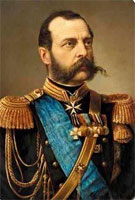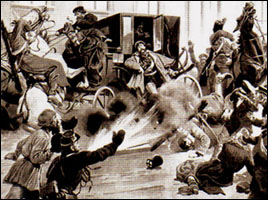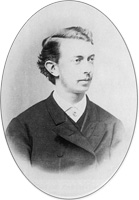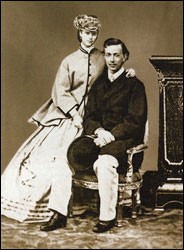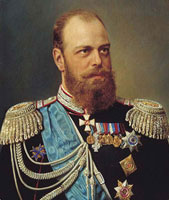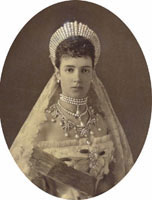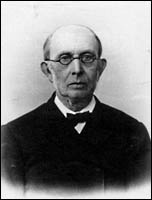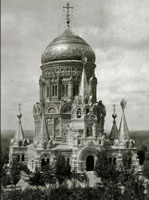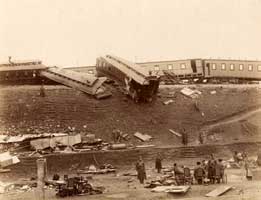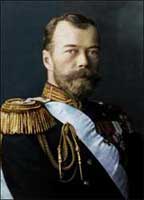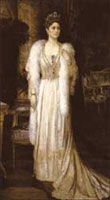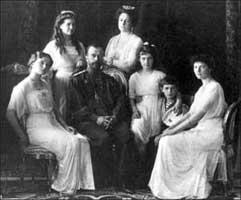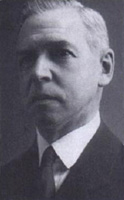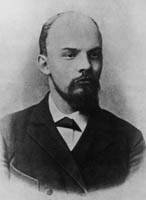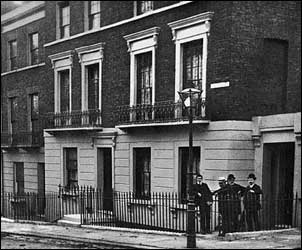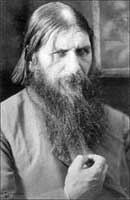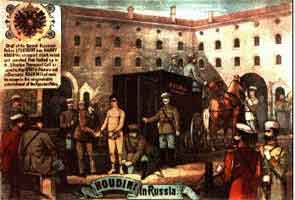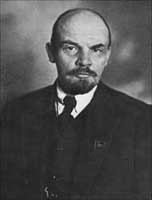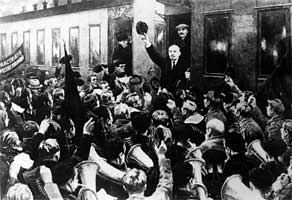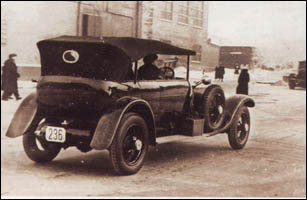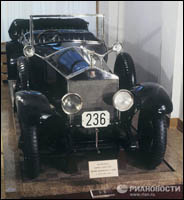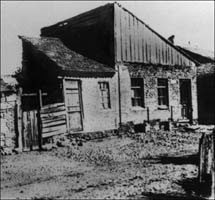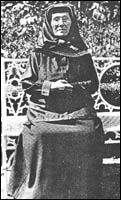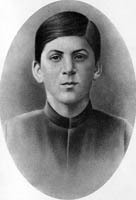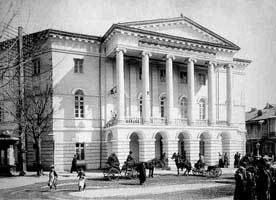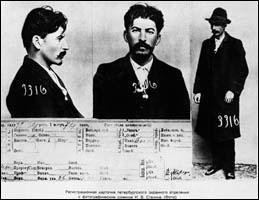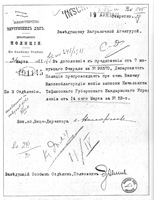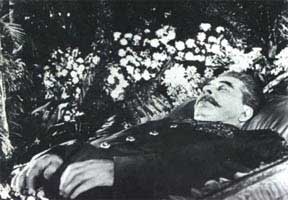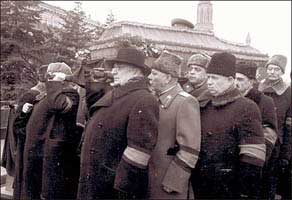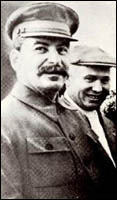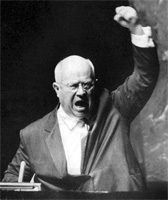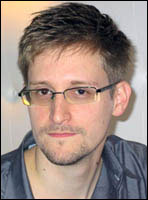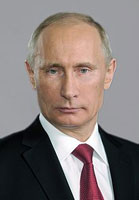The British Secret Service has been spying on Mother Russia for centuries, but after the Fall of the Papal States the spying became overt and intense. The Russian equivalent to the U.S. Secret Service was called the Okhrana. Tsar Alexander II was one of the greatest Tsars in the Romanov dynasty. He was close friends with the Prussian King Wilhelm I and Bismarck. During the Franco-Prussian War, he warned Austria not to help France, and this led to the Fall of the Papal States and the unification of Italy . . . and Germany!!
His son, Tsarevitch Alexander, arrived on the scene shortly thereafter and saw his father's mangled body. Alexander II was the most successful Russian reformer since Peter the Great. His most important achievement was the emancipation of the serfs in 1861, for which he became known as Alexander the Liberator. The Tsar was responsible for numerous other reforms including reorganizing the judicial system, setting up elected local judges, abolishing capital punishment, promoting local self-government through the zemstvo system, imposing universal military service, ending some of the privileges of the nobility, and promoting the universities. Just before his assassination, he was about to grant his people even more liberty:
The Tsar was succeeded by his oldest surviving son, Alexander Alexandrovich. The Tsar had an older son, Tsarevich Nicholas, who died of poisoning in France.
All the hopes of Alexander rested in his beloved son and heir Nicholas:
Before his death, Nicholas expressed a wish that his fiancée become the bride of his younger brother Alexander (Sasha), and successor as Tsarevich.
Even though he was a giant of a man, he did not possess his father's courage and he lived in fear of assassination. He was also dominated by the strong-willed Marie Feodorovna. Whenever he traveled through the vast Russian empire he relied on the Cossacks for protection. The Okhrana was created during the reign of Tsar Alexander IIIThe British branch of the Russian Secret Service was created in 1887. The Department for the Protection of Order and Public Safety was better known by its acronym, Okhrana:
The sinister, reactionary Konstantin Pobyedonostsyev was the main advisor to Tsar Alexander. He was known as the "Black Tsar" because of his dark countenance and dour disposition. He can be rightfully called the "Father" of the Okhrana.
Pobyedonostsyev was a shrewd lawyer who knew well the dire implications that an atheistic regime would have on Orthodox Russia . . . and the entire world!! Rachkovsky worked in Paris, Geneva, and Rome. In Rome he worked to establish diplomatic relations between the Vatican and Russia. His attempt to supplant the Orthodox Church with the Latin Church ended in abysmal failure. The Russian branch of the British Secret Service didn't do such a good job at "protecting" the Tsar because his entire family was almost killed in a train wreck.
After seeing his father mangled by a bomb, the near escape had a horrifying effect on the Tsar . . . and Tsarina:
All
the common people in Russia gave thanks to the Almighty for sparing
the life of their Tsar. The Tsar was a very moral and upright man and
was genuinely concerned for the welfare of all his people.
Tsar Alexander III succumbed to poison in 1894The many attempts on his life caused the Tsar to become more remote from his people. His attempted murder in the train wreck having failed, his doctors finally managed to poison him:
Alexander was succeeded by his 26-year-old son Nicholas. The new Tsar was woefully unprepared to assume rulership of the largest country in the world at such a young age. A disastrous war with Japan in 1905, followed by a war with Germany in 1914, led to the downfall of the Romanov dynasty and the Russian Revolution.
The story of the murder of the Tsar and his family by "Bolsheviks" in 1918 is just disinformation....It was concocted by the same people who invented the fable of Hitler committing suicide in the Fuhrerbünker after just getting married.
Together with the British ambassador, Sir George Buchanan, he arranged for the Romanovs to "escape" to Britain:
From Ekaterinburg, the family traveled by train to Vladivostok, guarded by general Michael Dieterich's soldiers. While en route to Britain, their ship simply "blew up." A watery grave meant no bodies as relics, and no heirs to continue the mighty Romanov dynasty. The Siberian route was already in use at the beginning of the war to finance Russian arms purchases in Britain:
All the vast gold holdings and treasure of Imperial Russia followed the St. Petersburg-Vladivostock-Vancouver, route. All the ships carrying the fabulous treasure made it safely to Vancouver. Gibbes later left Russia on the same British High Commission for Siberia train. The Orthodox Church fell with the fall of the Tsar. To assuage a guilty conscience for destroying Orthodoxy, Gibbes later became an Orthodox monk!! Vladimir Lenin's Rolls Royce!!Vladimir Ilyich Lenin's real name was Vladimir Ilyich Ulyanov. Ulyanov had an older brother named Aleksandr, who was hanged in 1887 for his involvement in a plot to murder Tsar Alexander III. In April 1902, Lenin and his wife Nada arrived in London from Geneva, and found lodgings at Holford Square in the home of Emma Louise Yeo.
Irish born spymaster William Melville introduced Lenin to escape artist Harry Houdini. Houdini's skills would be very useful to Lenin when he returned to Russia.
For the next 14 years, Lenin divided his time between Munich, Geneva, and London while the Okhrana planned the Russian Revolution.
Lenin was an admirer of all things British–especially the aristocracy....Nothing epitomized the aristocracy more than Rolls-Royce automobiles. Lenin's Rolls was a genuine "gift" from the British . . . and not a leftover from the Tsar's fleet. Lenin loved to sit in the back of his Rolls while he planned the "peoples' revolution." If you couldn't afford a chauffeur . . . you didn't belong in a Rolls.
Lenin was head of the newly formed Soviet Union until he suffered a "stroke" in 1922. He never recovered, so in 1924 he was replaced by Joseph Stalin. Joseph Stalin the Okhrana agent!!Joseph Stalin's real name was Iosef Dzugashvili. His mother's name was Ekaterina and his real father was an "Orthodox priest" named Koba Egnatashvili.
Stalin was physically deformed when he was born. One arm was shorter than the other and the second and third toes on his left foot were fused together. There are many cases in the Bible of women having sex with demons and producing monstrosities like Goliath of Gath. In the village where Stalin was born many people believed that he was illegitimate:
Ultimately, Satan himself was the father of the monster Joseph Stalin. Georgia was an outpost of the British Empire and the place was crawling with Okhrana agents. When he was 16, Stalin's real father obtained a place for him at the Tiflis Theological "Seminary."
Stalin never graduated formally from the "seminary." He was expelled for "reasons unknown" in 1899. In the 5 years at the "seminary," he learned all the tricks of the spying trade that enabled him to become a brutal dictator of the Soviet Union. To establish his identity as a counter-revolutionary, Stalin was arrested several times by the Okhrana. The mug shots were taken in 1911, and the Eremin letter was written at the same time.
All during his infamous career as dictator of the Soviet Union, Stalin was paranoid that he would be exposed as an Okhrana agent. In 1937, he had a copy of the Eremin letter forged, with some major mistakes, that he hoped would discredit the letter. Joseph Vissarionovich Djugashvili did not use the pen name "Stalin" in 1911, and Okhrana agents were not known by their nom-de-plumes. Here is the text of the "revised" letter in English:
The only document extant linking him to the Okhrana is in the Okhrana archive at the Hoover Institution, Stanford University, California. Like his fellow spy Hitler in Germany, Stalin was raised to the status of a divine being or demigod. All opposition to his rule was ruthlessly crushed. Famines, purges. collectivization, etc., etc., led to the deaths of countless millions. In 1941, he signed a non-aggression pact with Hitler which led to WWII. It was only the Serbs delaying Hitler's invasion of Russia that saved that country from complete annihilation.
Stalin's funeral in Red Square was another vast propaganda production by the "Communists." Anybody who didn't "mourn" the death of this spy was likely to be arrested and shot by the KGB. Stalin was succeeded by fellow secret agent Nikita Khrushchev. Khrushchev gave away Crimea in 1954Nikita Krushchev wa born on April 15, 1894, in the southern Russian village of Kalinovka, close to the present-day border between Ukraine and Russia. When he was 14 he joined a British mining company in Donetsk, Ukraine. Donetsk was founded in 1869 when a British businessman named John Hughes built a steel plant and several coal mines in the southern part of the Russian Empire at Aleksandrovka. As part of the British Empire, the town initially was given the name Hughesovka. In 1918, he became a "political commissar" in the Red Army which is just another name for spy.
Here is a brief excerpt from a 2003 biography of Nikita Khrushchev: A decade before Khrushchev extracted the Crimea from Russia and benevolently presented it to Ukraine (thus ensuring trouble between the two after the collapse of the USSR in 1991), he tried to pull off the same trick in 1944. What gave him an opening was the Crimea's need for Ukrainian peasants to replace the Crimean Tatars Stalin had forcibly exiled from the area. When he was in Moscow, he told a Ukrainian colleague later that year, he said "Ukraine is in ruins, but everybody wants something from it. Now what if it received the Crimea in return?"(Taubman, Khrushchev: The Man and His Era, p 186). When Khrushchev became head of the Soviet Union, he "gifted" Crimea to Ukraine. The transfer merited only a paragraph in Pravda, the official Soviet newspaper, on Feb. 27, 1954. The story was one long sentence and dense with detail. Here's what it said:
And without the Crimeans having any say in the matter, a region that had been part of Russia for centuries became part of Ukraine! One of the oldest tricks in spying is for someone to "defect" to the enemy. That spy gives valuable information, but it is never of any real substance . . . just enough to gain the trust of the other side....Once accepted as a genuine turncoat, that spy can then serve the cause of his real masters. Such an operative is called a disinformation agent.
For over 1000 years, Old Rome fought vainly against New Rome or Constantinople. Old Rome called the East-West split the "Great Schism." In reality, it is the Latins who are the schismatics because of the 4 Deadly Errors of the Latins. When New Rome fell to the Terrible Turks on May 29, 1453, the Orthodox Church moved to Russia and Moscow became known as the 3rd Rome. Moscow now became the target of Old Rome. As early as the time of Queen Elizabeth I, the British Secret Service had their agents at the Court of Tsar Ivan I. When President Lincoln saved the Union in 1865, a new strategy was adopted to use the vast power and wealth of the United States against the Russian Orthodox Church. Thus the British Secret Service came out of the closet and opened up branches in the United States and Russia. The Exodus is a marvelous type of Armageddon and the end of the world. When the Egyptians were pursuing the children of Israel at the Red Sea, JEHOVAH sent his MECHANIC-ANGELS to pull off the wheels of their chariots–in order to slow them down:
In these last days . . . we cannot stop the Vatican and NATO's mad attempt to end what they call the "Great Schism" but we can slow them down . . . so all true Christians should become MECHANICS for CHRIST!! Vital links References
Brackman, Roman, The Secret File of Joseph Stalin. Frank Cass Publishers, London & Portland, OR, 2001. Benagh, Christine, An Englishman in the Court of the Tsar. Conciliar Press, Ben Lomond, California, 2000. Cook, Andrew. M: MI5's First Spymaster. Tempus Publishing Group, Stroud, Gloucestershire, UK, 2004. (A biography of William Melville). Clarke, William. The Lost Fortune of the Tsars. St. Martin's Press, New York, 1994. Hall, Coryne. Little Mother of Russia: A Biography of Empress Marie Feodorovna. Hingley, Ronald. The Russian Secret Police: Muscovite, Imperial Russian, and Soviet Political Security Operations. Simon & Schuster, New York, 1970. Kalush, William& Sloman, Harry. The Secret Life of Houdini: The Making of America's First Superhero. Simon & Schuster, New York, 2006 Lowe, Charles. Alexander III of Russia. William Heinemann, London, 1895. Levine Isaac Don, Stalin's Great Secret. Coward-McCann, Inc., New York, 1956. Magocsi, Paul Robert. A History of Ukraine. University of Washington Press, Seattle, 1996. Rappaport, Helen, Conspirator: Lenin in Exile. Perseus Book Group, New York, 2010. Radzinsky, Edvard. Alexander II: The Last Great Tsar; Simon & Schuster, New York, 2005. McNeal,Shay. The Secret Plot to Save the Tsar: New Truths Behind the Romanov Mystery. HarperCollins, New York, 2002. Smith, Edward Ellis, The Young Stalin: The Early Years of an Elusive Revolutionary. Farrar, Straus & Giroux, New York, 1967. Summers, Anthony. The File on the Tsar. Harper & Row, New York, 1976. Taubman, William. Khrushchev: The Man and His Era. W.W. Norton & Company, New York, 2003. Copyright © 2014 by Patrick Scrivener
|
||||||||||||||||||||||||||||||||||||||||||||||||||||||||||||||||||||||||||||||||||||||||||||||||||||||||||||||||||
